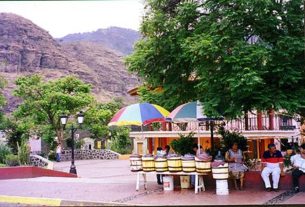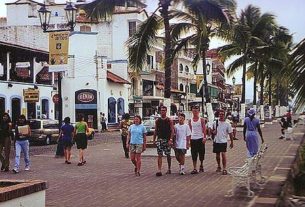With the possible exception of André Malraux, no individual associated with the arts has been involved in direct political action more than David Alfaro Siqueiros. Student agitator, soldier, leader of an assassination squad — Siqueiros was all of those things. Yet he is also considered one the artistic masters of the twentieth century, a member of that great Mexican school of mural painting that includes José Clemente Orozco and Diego Rivera. Creative and innovative, always interested in new techniques and materials, Siqueiros frequently used pyroxylin, a substance related to gun-cotton, which dries with amazing speed.
Siqueiros was born in Chihuahua City in 1896. Between 1908 and 1911 he studied at the Franco-English College in Mexico City, an institution run by the Marist Fathers. Like so many prominent Marxists and atheists in Latin countries, Siqueiros had an early Catholic education.
By the tender age of fifteen Siqueiros was already involved in artistic studies and political activism. In 1911 he led a student strike at the San Carlos Academy (later the Academy of Fine Arts), one designed to force changes in teaching methods, The strike lasted six months and ended in complete victory for the students.
In 1913, following the overthrow and assassination of Madero, Siqueiros conspired with a group of students and workers to unseat Victoriano Huerta, the general who had masterminded the conspiracy against Madero and now ruled as a military dictator. He joined the anti-Huerta Constitutionalist movement and contributed to its newspaper, La Vanguardia. After serving four years as an active combatant during the Revolution, he attained the rank of captain. In 1918, in Guadalajara, Siqueiros organized a group called the Congress of Soldier Artists.
In 1919 Siqueiros went to Spain. In Barcelona, in 1921, he published a magazine called Vida Americana. Returning to Mexico in 1922, he painted his famous mural, “Los Mitos”, (“The Myths”) in the patio of the National Preparatory School. In 1923 he was elected secretary general of Mexico’s Revolutionary Painters, Sculptors and Engravers Union. The following year Siqueiros, Diego Rivera and Javier Guerrero started a weekly called El Machete that was sponsored by the union. El Machete would later become the official organ of Mexico’s Communist Party,
1924 found Siqueiros in Guadalajara, where he collaborated with Amado de la Cueva in woodcarving and mural work at the old Santo Tomás Church, now the property of the university. The years 1926-30 found him up to his neck in union activity, as secretary general of the Miners Union and of the Jalisco Workers Federation. His militancy got him thrown into jail several times and in 1931 he was confined to Taxco in a status of internal exile.
These restrictions in no way dampened Siqueiros’s creative spirit. While in Taxco he completed over a hundred paintings; these were exhibited in Mexico City’s Casino Español. Professional recognition did not prevent the government from taking action against a man who by now they considered a dangerous subversive. Expelled from Mexico in 1932, he came to Los Angeles where he painted three pictures to be exhibited locally — Mitin obrero (“Workers’ Meeting”) at the Chouinard School of Art, América tropical at the Plaza Art Center, and Retrato actual de México (“Current Portrait of Mexico”) in a private residence at Santa Monica.
In 1934 the left-wing President Lázaro Cárdenas came to power and Siqueiros was once again welcome in Mexico. The following year he headed an experimental workshop in New York. In 1936, when the Spanish Civil War broke out, he went to Spain and enlisted in the antifascist forces. Siqueiros served three years in Spain, rising to the rank of lieutenant colonel. After Franco’s victory in 1939, he returned to Mexico. Under the sponsorship of the Electrical Workers Union he painted another of his celebrated murals, “Portrait of the Bourgeoisie.”
In the great Stalin-Trotsky schism that split the communist world, Siqueiros was firmly on the side of Stalin. So firmly that on in the early morning of May 24, 1940, he led an attack on Trotsky’s house in Mexico City’s Coyoacán suburb. (Trotsky, granted asylum by President Cárdenas, was then living in Mexico.) The attacking party was composed of men who had served under Siqueiros in the Spanish Civil War and of miners from his union. After thoroughly raking the house with machine gun fire and explosives, the attackers withdrew in the belief that nobody could have survived the assault. They were mistaken. Trotsky was unhurt and lived till August, when he was killed with a pickaxe wielded by an assassin who had wormed his way into the ex-Soviet leader’s entourage by romancing one of his secretaries. Shortly before the attack, Siqueiros had been censured for mishandling Communist Party funds. Isaac Deutscher, Trotsky’s biographer, believed that Siqueiros planned the attack to get back into the Party’s good graces. Describing Siqueiros as a “Latin American buccaneer,” Deutscher describes him as a man in whom “art, revolution and gangsterism were inseparable.”
During the Second World War Siqueiros painted a number of pictures that depict the struggle against fascism and other progressive themes. These include “Death to the Invader,” “There Is no Other Road but Ours,” “A New Day for Democracy” and “Fraternity Between the Black and White Races.”
In 1947 Siqueiros exhibited 70 easel paintings at the Palacio de Bellas Artes in Mexico. These include a self-portrait called El Coronelazo and “The Devil in the Church,” a painting with an anticlerical motif. In the next eight years he painted some of his better known murals, including “Man, the Master and not the Slave of the Machine,” “The Future Victory of Medical Science Against Cancer,” “The People and the University, the University for the People” and “The Revolution Against the Porfirian Dictatorship.”
At the same time, Siqueiros remained intensely political. In 1959 he was jailed by President Adolfo López Mateos for “social dissolution” because he supported leaders of the railroad workers union, who were imprisoned for the same offense, when they organized a nation-wide strike.
Released in 1964, Siqueiros continued as a partisan of international Marxism. A supporter of Castro’s Cuba and a foe of U.S. intervention in Vietnam, he was awarded the Lenin Peace Prize in 1967.
In the final decade of his life, Siqueiros set up a workshop in Cuernavaca and painted his most ambitious work, a huge mural called “The March of Humanity.” When it was inaugurated, on December 15, 1971, President Luis Echeverria was in attendance. Because he had been blamed for the Tlatelolco massacre, that took place while he was interior minister, Echeverria was trying to project a populist image and mend fences with the left.
Siqueiros died in 1974 in his adopted city of Cuernavaca. A fellow artist, José Revueltas, described him as “a great mural of Mexico” who was as “titanic as his painting.”


